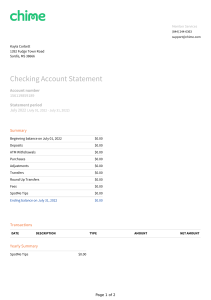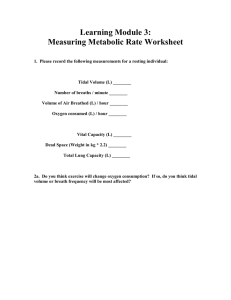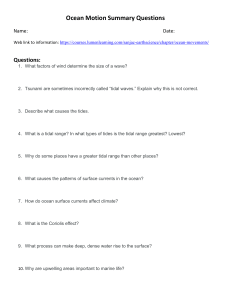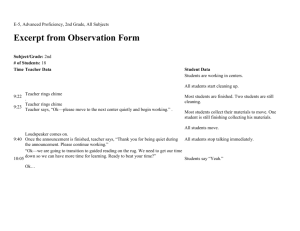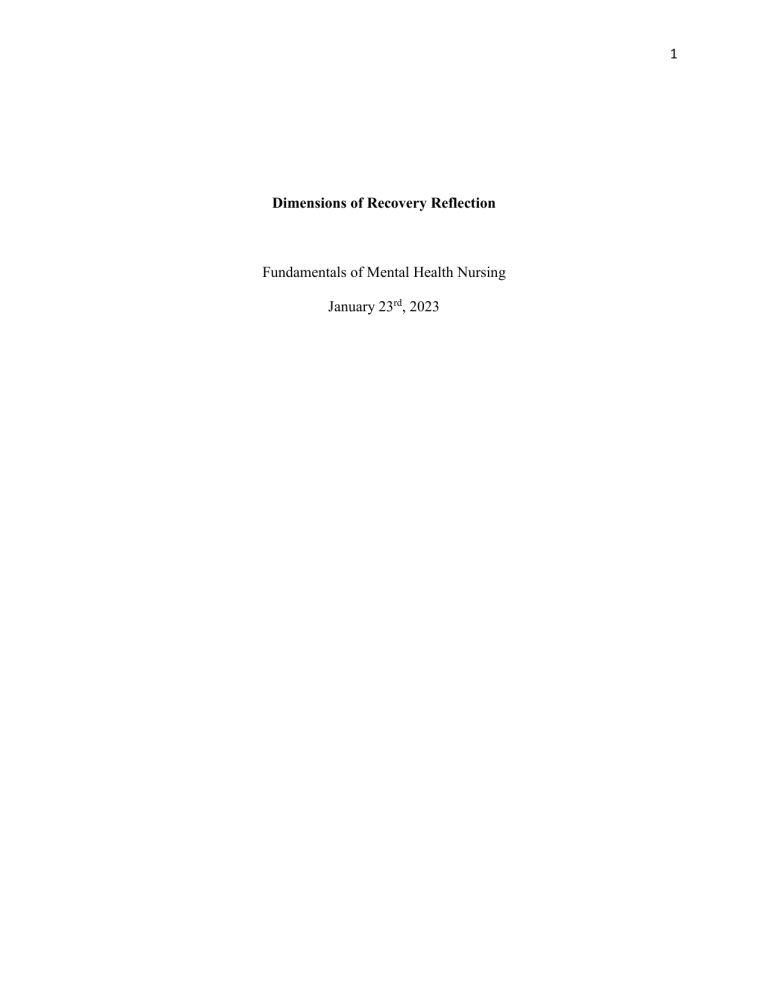
1 Dimensions of Recovery Reflection Fundamentals of Mental Health Nursing January 23rd, 2023 2 The Mental Health Commission of Canada's Guidelines for Recovery-Oriented Practice provides guidelines for people who are working or volunteering in the field of mental health care to help individuals with the process and journey of recovery (Mental Health Commission of Canada, 2020). Recovery from a mental illness is unique to every individual and is not a one-size fits all philosophy. Mental Health Commission of Canada recognizes that one aspect of recovery is an active, dynamic relationship between the patient and the support person or team, which can be friends, family, and/or health care providers, where goals, treatments, and care are decided together. The Recovery-Oriented Practice highlights 6 dimensions with skills and behaviors health care providers and other providers can use to enact the dimension. The dimensions are targeted toward the provider in the patient-provider relationship. The first dimension is "creating a culture and language of hope" where the provider creates a welcoming and accepting environment, clearly communicates goals and outcomes, provides hope, and encourages connections with peers who have similar experiences, etc. (Mental Health Commission of Canada, 2020). Hope is essential for the recovery process of an individual. Creative Tea (2022) says hope is the starting point for a mental health system geared towards fostering recovery. Spreading and promoting hope as a provider is important to make the patient feel valued, safe and optimistic. The second dimension is "recovery is personal" where the provider can respectfully explore one's history and story, work with individuals/support circle to create unique goals, encourage people's belief in ability to recover, etc. (Mental Health Commission of Canada, 2020). This dimension highlights the importance on client-centered care where the client is placed in the middle and their individual needs and strengths are the focus. The third dimension is "recovery occurs in the context of one's life" where the provider identifies people in the 3 patients' life to be involved in care, provide resources and information on services close to individual, start peer-led community partnerships, address the stigma around mental illness within the community, etc. (Mental Health Commission of Canada, 2020). Understanding the larger picture and the context the individual lives in with regards to culture, stigma, workplaces, etc. is important to support recovery. Many different factors contribute to one's mental health and ability to cope and/or recover. The fourth dimension is "responding to the diverse needs of everyone living in Canada" where the provider ensures care is tailored to gender differences and sexual orientation, culture and backgrounds, the different stages in one's life and they proactively seek out information about one's needs, expectations and preferences, etc. (Mental Health Commission of Canada, 2020). Canada is a diverse country with immigrants, refugees, varying cultures, ages, LGBTQ2S+ community and recovery must meet the needs of all individuals. The fifth dimension is "working with First Nations, Inuit, Metis" where the provider reflects on own beliefs, biases and assumptions about the impact of colonization, collaborates with elders and communities, actively works to address racism and discrimination, and creates safe and respectful places for people who have experienced trauma, etc. (Mental Health Commission of Canada, 2020). The providers practice cultural safety to ensure a healthy, respectful, safe environment where the needs and rights of Indigenous people are met. The last and sixth dimension is "recovery is about transforming services and systems" where the provider collaborates with others who have lived mental health experience, incorporates recovery principles and values into all areas of organization, make supporting recovery the shared goal of all service partnerships, engages in continues reflection to increase knowledge, etc. (Mental Health Commission of Canada, 2020). This dimension zooms out from the patient and direct provider or support team and looks at the organizations and policies involved with recovery. It 4 addresses the need for recovery to be ongoing and a journey shared by all in a community. The Mental Health Commission of Canada's Guidelines for Recovery-Oriented Practice is a holistic approach involving the patient, family, friends, support workers, health care providers, organizations and services, and others involved in mental health care. In this weeks’ readings and videos, we also explored two other models of recovery; the CHIME and Tidal models. The CHIME model is a framework for recovery where CHIME stands for Connectedness, Hope, Identity, Meaning, and Empowerment (AMI-Quebec, 2022). The Tidal theory help patients create their own journey of discovery and uses the metaphor of a “shipwreck” and navigating through a storm (SOSU Fyn, 2014). The tidal model focuses on the patient’s strengths, wishes, goals, and experiences. There are similarities and differences between the Recovery-Oriented Practice (ROP) guidelines and the CHIME and Tidal models. All three models focus on recovery and place the patient in the center of the process. They acknowledge that every person’s journey through mental illness and recovery is unique and treatments, care, services, etc. should be adapted accordingly. The ROP and CHIME models describe hope as the building blocks to recovery and an essential step to the process of improving one’s well-being. The patient and the provider must have hope and promote hope. All three methods mention empowerment of self and provider. It is important to take responsibility for one’s recovery process. The ROP and Tidal methods mention recovery is about the patient reclaiming their story or space and giving them back the control of their life and decisions. In contrast, there are some differences between the models. The ROP focuses on what the mental health provider, communities and organizations, as well as the patient can do in the recovery process where the CHIME and Tidal models are more focused on solely the patient and the direct contact with the provider. The CHIME and Tidal methods are more of an in depth look 5 whereas the ROP is a more zoomed out perspective of the whole recovery process. The Tidal method outlines 6 assumptions and needs that must be accepted by the provider to engage in the model (Petiprin, 2022). The ROP identifies key guidelines and action items to be followed rather than assumptions or beliefs that represented by the CHIME and Tidal theories (Mental Health Commission of Canada, 2020). In conclusion, the ROP guidelines and CHIME and Tidal models are important in the recovery process. All methods highlight essential steps and areas to begin, maintain and achieve recovery from a mental illness. Although, there are differences between the three models, all focus on client-centered care. 6 References AMI-Quebec. (Nov 11, 2022). What is the CHIME Model of Recovery? [Video]. YouTube. Creative Tea. (Aug 29, 2022). Mental Health Recovery is Personal. [Video] YouTube. Mental Health Commission of Canada. (2020). Putting recovery into practice. An introduction to the Guidelines for Recovery-Oriented Practice. Ottawa, Canada. Petiprin, A. (2020). Barker's Tidal Model of Mental Health Recovery. Nursing Theory. https://nursing-theory.org/theories-and-models/barker-tidal-model-of-mental-healthrecovery.php SOSU Fyn. (May 8, 2014). The Tidal Model - by Dr. Phil Barker [Video]. YouTube.
